Management Essay: Cultural Differences and Nonverbal Communication
VerifiedAdded on 2023/01/23
|7
|1929
|39
Essay
AI Summary
This essay investigates the significant impact of cultural differences on the interpretation of nonverbal communication. It begins by exploring kinesics, including posture, facial expressions, and gestures, and how their meanings vary across cultures, potentially leading to misunderstandings and conflicts. The essay then delves into paralinguistics, examining how non-speech sounds like volume, pitch, and silence convey different meanings in various cultural contexts, providing examples of misinterpretations due to silence. Finally, it discusses haptics, the role of touch in communication, and how cultural norms influence its acceptability and interpretation, highlighting the potential for conflicts arising from differing views on physical contact. The conclusion emphasizes that cultural differences significantly affect nonverbal communication and the need to be aware of these differences to improve communication in management contexts.
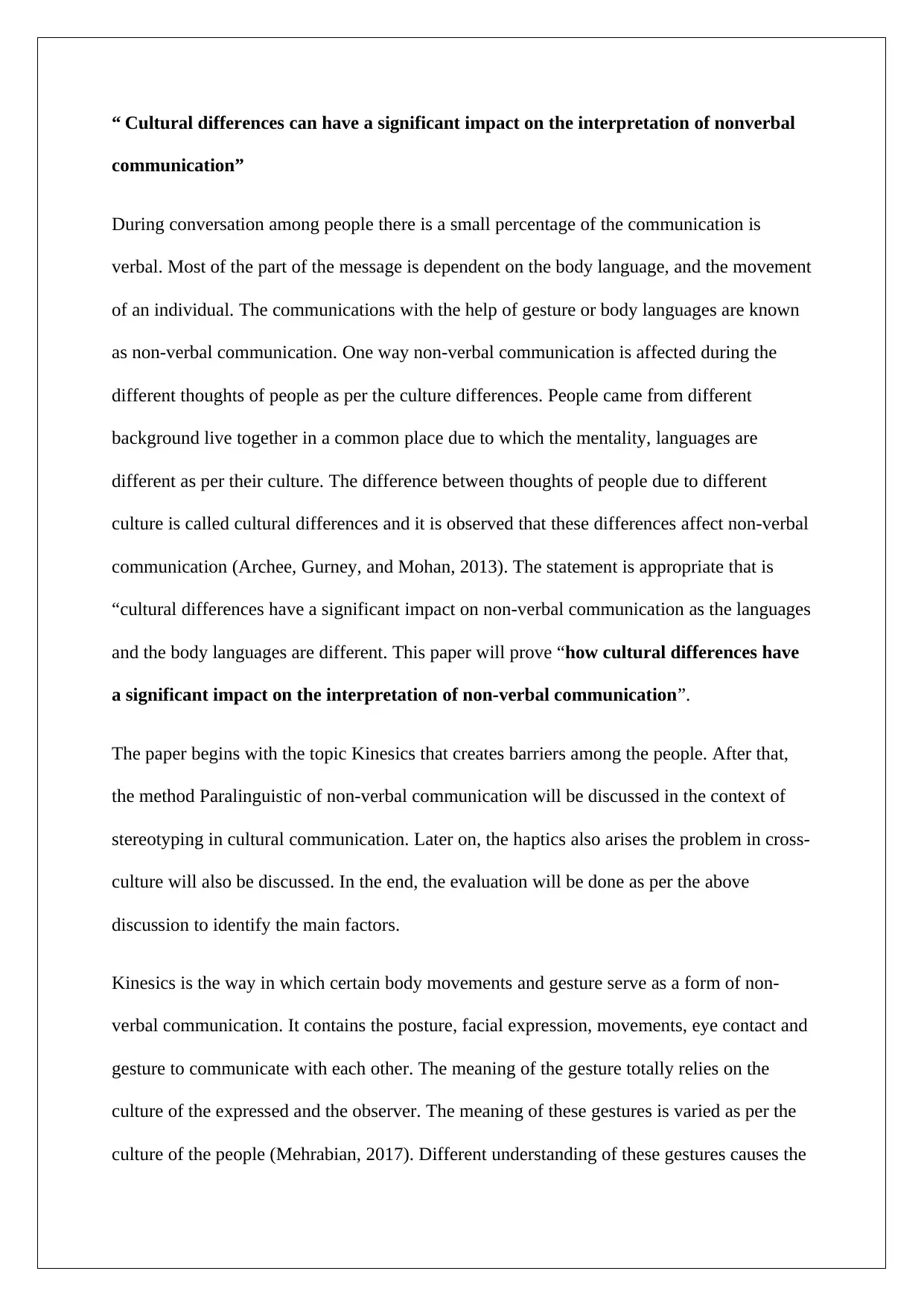
“ Cultural differences can have a significant impact on the interpretation of nonverbal
communication”
During conversation among people there is a small percentage of the communication is
verbal. Most of the part of the message is dependent on the body language, and the movement
of an individual. The communications with the help of gesture or body languages are known
as non-verbal communication. One way non-verbal communication is affected during the
different thoughts of people as per the culture differences. People came from different
background live together in a common place due to which the mentality, languages are
different as per their culture. The difference between thoughts of people due to different
culture is called cultural differences and it is observed that these differences affect non-verbal
communication (Archee, Gurney, and Mohan, 2013). The statement is appropriate that is
“cultural differences have a significant impact on non-verbal communication as the languages
and the body languages are different. This paper will prove “how cultural differences have
a significant impact on the interpretation of non-verbal communication”.
The paper begins with the topic Kinesics that creates barriers among the people. After that,
the method Paralinguistic of non-verbal communication will be discussed in the context of
stereotyping in cultural communication. Later on, the haptics also arises the problem in cross-
culture will also be discussed. In the end, the evaluation will be done as per the above
discussion to identify the main factors.
Kinesics is the way in which certain body movements and gesture serve as a form of non-
verbal communication. It contains the posture, facial expression, movements, eye contact and
gesture to communicate with each other. The meaning of the gesture totally relies on the
culture of the expressed and the observer. The meaning of these gestures is varied as per the
culture of the people (Mehrabian, 2017). Different understanding of these gestures causes the
communication”
During conversation among people there is a small percentage of the communication is
verbal. Most of the part of the message is dependent on the body language, and the movement
of an individual. The communications with the help of gesture or body languages are known
as non-verbal communication. One way non-verbal communication is affected during the
different thoughts of people as per the culture differences. People came from different
background live together in a common place due to which the mentality, languages are
different as per their culture. The difference between thoughts of people due to different
culture is called cultural differences and it is observed that these differences affect non-verbal
communication (Archee, Gurney, and Mohan, 2013). The statement is appropriate that is
“cultural differences have a significant impact on non-verbal communication as the languages
and the body languages are different. This paper will prove “how cultural differences have
a significant impact on the interpretation of non-verbal communication”.
The paper begins with the topic Kinesics that creates barriers among the people. After that,
the method Paralinguistic of non-verbal communication will be discussed in the context of
stereotyping in cultural communication. Later on, the haptics also arises the problem in cross-
culture will also be discussed. In the end, the evaluation will be done as per the above
discussion to identify the main factors.
Kinesics is the way in which certain body movements and gesture serve as a form of non-
verbal communication. It contains the posture, facial expression, movements, eye contact and
gesture to communicate with each other. The meaning of the gesture totally relies on the
culture of the expressed and the observer. The meaning of these gestures is varied as per the
culture of the people (Mehrabian, 2017). Different understanding of these gestures causes the
Paraphrase This Document
Need a fresh take? Get an instant paraphrase of this document with our AI Paraphraser
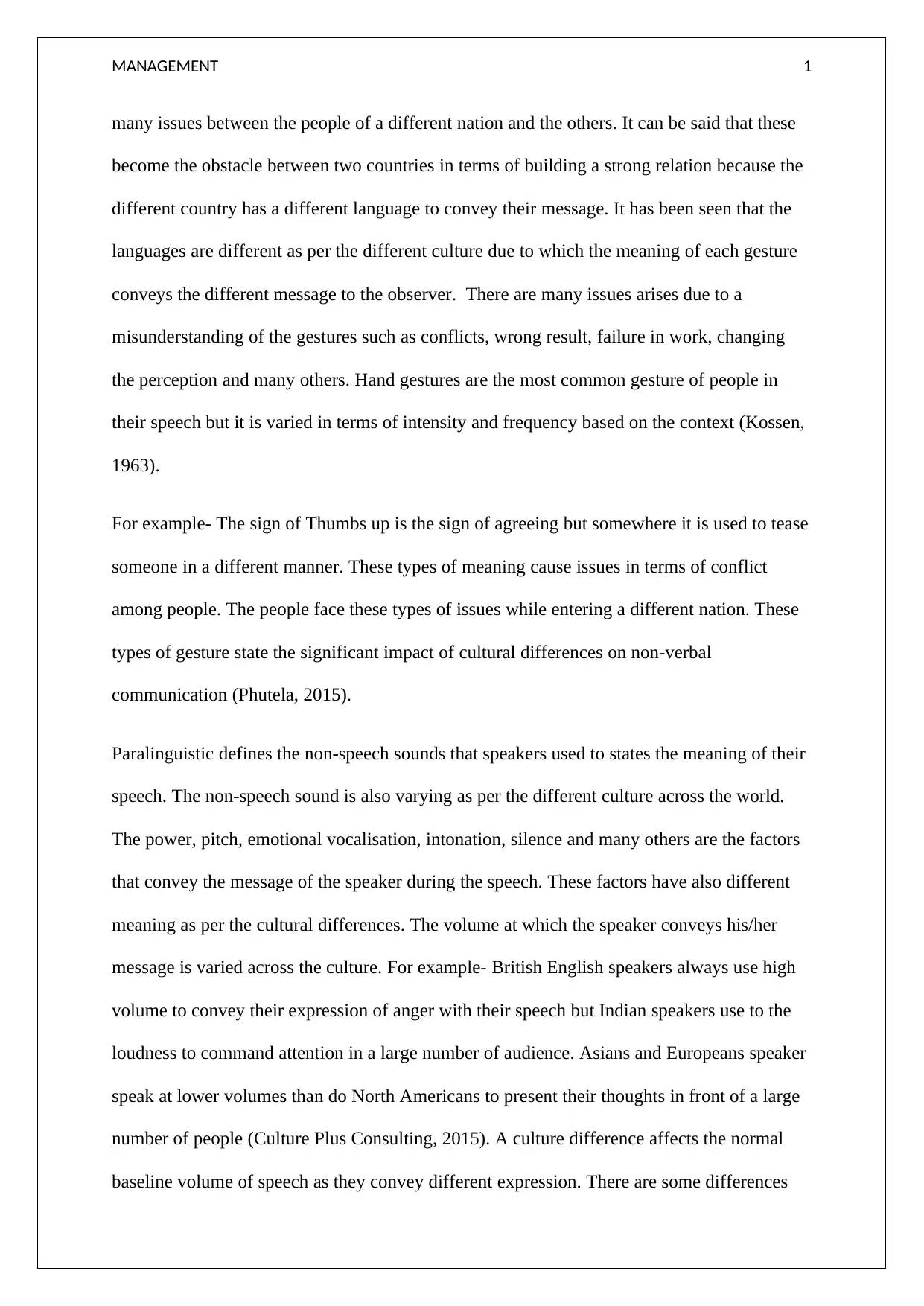
MANAGEMENT 1
many issues between the people of a different nation and the others. It can be said that these
become the obstacle between two countries in terms of building a strong relation because the
different country has a different language to convey their message. It has been seen that the
languages are different as per the different culture due to which the meaning of each gesture
conveys the different message to the observer. There are many issues arises due to a
misunderstanding of the gestures such as conflicts, wrong result, failure in work, changing
the perception and many others. Hand gestures are the most common gesture of people in
their speech but it is varied in terms of intensity and frequency based on the context (Kossen,
1963).
For example- The sign of Thumbs up is the sign of agreeing but somewhere it is used to tease
someone in a different manner. These types of meaning cause issues in terms of conflict
among people. The people face these types of issues while entering a different nation. These
types of gesture state the significant impact of cultural differences on non-verbal
communication (Phutela, 2015).
Paralinguistic defines the non-speech sounds that speakers used to states the meaning of their
speech. The non-speech sound is also varying as per the different culture across the world.
The power, pitch, emotional vocalisation, intonation, silence and many others are the factors
that convey the message of the speaker during the speech. These factors have also different
meaning as per the cultural differences. The volume at which the speaker conveys his/her
message is varied across the culture. For example- British English speakers always use high
volume to convey their expression of anger with their speech but Indian speakers use to the
loudness to command attention in a large number of audience. Asians and Europeans speaker
speak at lower volumes than do North Americans to present their thoughts in front of a large
number of people (Culture Plus Consulting, 2015). A culture difference affects the normal
baseline volume of speech as they convey different expression. There are some differences
many issues between the people of a different nation and the others. It can be said that these
become the obstacle between two countries in terms of building a strong relation because the
different country has a different language to convey their message. It has been seen that the
languages are different as per the different culture due to which the meaning of each gesture
conveys the different message to the observer. There are many issues arises due to a
misunderstanding of the gestures such as conflicts, wrong result, failure in work, changing
the perception and many others. Hand gestures are the most common gesture of people in
their speech but it is varied in terms of intensity and frequency based on the context (Kossen,
1963).
For example- The sign of Thumbs up is the sign of agreeing but somewhere it is used to tease
someone in a different manner. These types of meaning cause issues in terms of conflict
among people. The people face these types of issues while entering a different nation. These
types of gesture state the significant impact of cultural differences on non-verbal
communication (Phutela, 2015).
Paralinguistic defines the non-speech sounds that speakers used to states the meaning of their
speech. The non-speech sound is also varying as per the different culture across the world.
The power, pitch, emotional vocalisation, intonation, silence and many others are the factors
that convey the message of the speaker during the speech. These factors have also different
meaning as per the cultural differences. The volume at which the speaker conveys his/her
message is varied across the culture. For example- British English speakers always use high
volume to convey their expression of anger with their speech but Indian speakers use to the
loudness to command attention in a large number of audience. Asians and Europeans speaker
speak at lower volumes than do North Americans to present their thoughts in front of a large
number of people (Culture Plus Consulting, 2015). A culture difference affects the normal
baseline volume of speech as they convey different expression. There are some differences
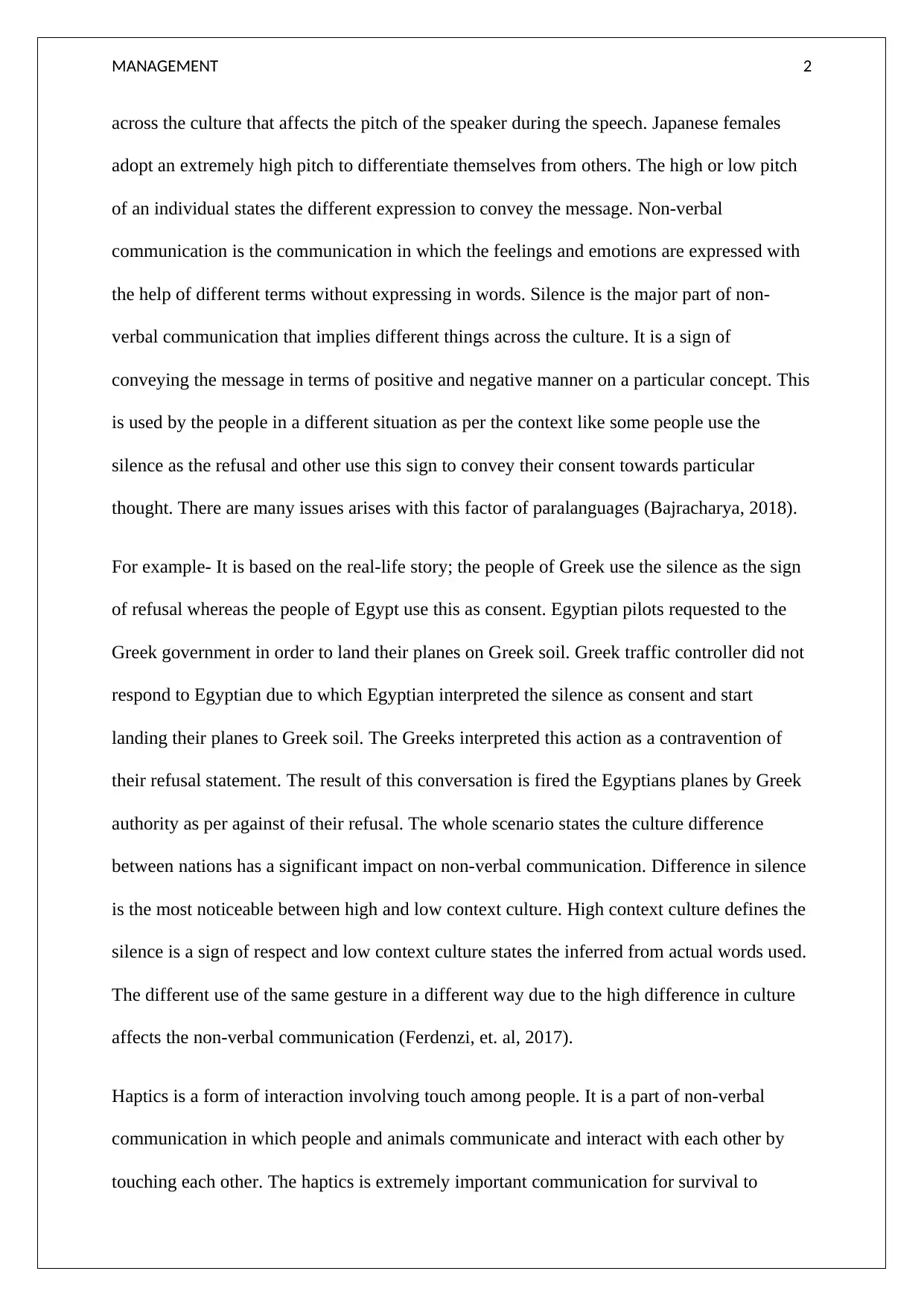
MANAGEMENT 2
across the culture that affects the pitch of the speaker during the speech. Japanese females
adopt an extremely high pitch to differentiate themselves from others. The high or low pitch
of an individual states the different expression to convey the message. Non-verbal
communication is the communication in which the feelings and emotions are expressed with
the help of different terms without expressing in words. Silence is the major part of non-
verbal communication that implies different things across the culture. It is a sign of
conveying the message in terms of positive and negative manner on a particular concept. This
is used by the people in a different situation as per the context like some people use the
silence as the refusal and other use this sign to convey their consent towards particular
thought. There are many issues arises with this factor of paralanguages (Bajracharya, 2018).
For example- It is based on the real-life story; the people of Greek use the silence as the sign
of refusal whereas the people of Egypt use this as consent. Egyptian pilots requested to the
Greek government in order to land their planes on Greek soil. Greek traffic controller did not
respond to Egyptian due to which Egyptian interpreted the silence as consent and start
landing their planes to Greek soil. The Greeks interpreted this action as a contravention of
their refusal statement. The result of this conversation is fired the Egyptians planes by Greek
authority as per against of their refusal. The whole scenario states the culture difference
between nations has a significant impact on non-verbal communication. Difference in silence
is the most noticeable between high and low context culture. High context culture defines the
silence is a sign of respect and low context culture states the inferred from actual words used.
The different use of the same gesture in a different way due to the high difference in culture
affects the non-verbal communication (Ferdenzi, et. al, 2017).
Haptics is a form of interaction involving touch among people. It is a part of non-verbal
communication in which people and animals communicate and interact with each other by
touching each other. The haptics is extremely important communication for survival to
across the culture that affects the pitch of the speaker during the speech. Japanese females
adopt an extremely high pitch to differentiate themselves from others. The high or low pitch
of an individual states the different expression to convey the message. Non-verbal
communication is the communication in which the feelings and emotions are expressed with
the help of different terms without expressing in words. Silence is the major part of non-
verbal communication that implies different things across the culture. It is a sign of
conveying the message in terms of positive and negative manner on a particular concept. This
is used by the people in a different situation as per the context like some people use the
silence as the refusal and other use this sign to convey their consent towards particular
thought. There are many issues arises with this factor of paralanguages (Bajracharya, 2018).
For example- It is based on the real-life story; the people of Greek use the silence as the sign
of refusal whereas the people of Egypt use this as consent. Egyptian pilots requested to the
Greek government in order to land their planes on Greek soil. Greek traffic controller did not
respond to Egyptian due to which Egyptian interpreted the silence as consent and start
landing their planes to Greek soil. The Greeks interpreted this action as a contravention of
their refusal statement. The result of this conversation is fired the Egyptians planes by Greek
authority as per against of their refusal. The whole scenario states the culture difference
between nations has a significant impact on non-verbal communication. Difference in silence
is the most noticeable between high and low context culture. High context culture defines the
silence is a sign of respect and low context culture states the inferred from actual words used.
The different use of the same gesture in a different way due to the high difference in culture
affects the non-verbal communication (Ferdenzi, et. al, 2017).
Haptics is a form of interaction involving touch among people. It is a part of non-verbal
communication in which people and animals communicate and interact with each other by
touching each other. The haptics is extremely important communication for survival to
⊘ This is a preview!⊘
Do you want full access?
Subscribe today to unlock all pages.

Trusted by 1+ million students worldwide
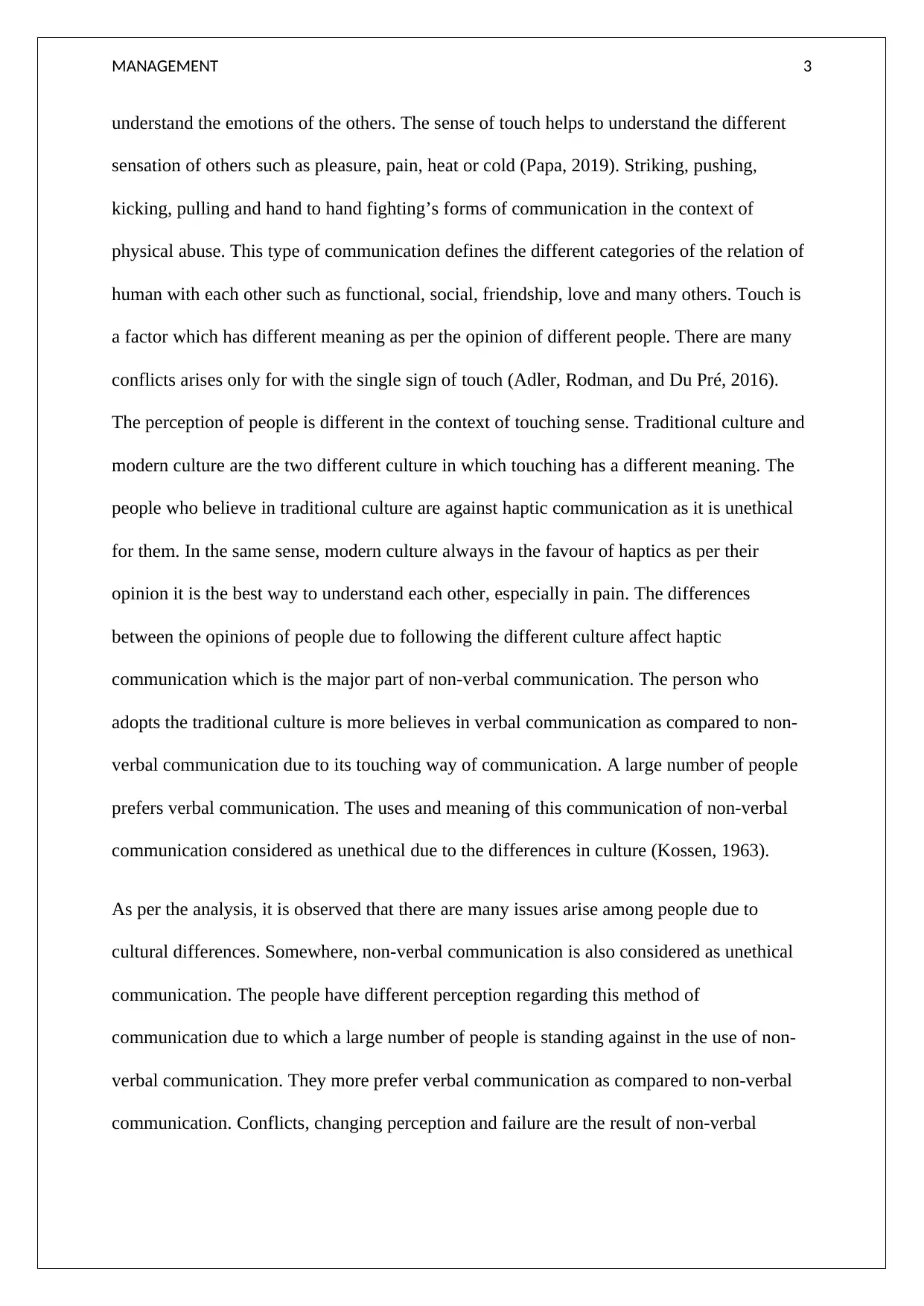
MANAGEMENT 3
understand the emotions of the others. The sense of touch helps to understand the different
sensation of others such as pleasure, pain, heat or cold (Papa, 2019). Striking, pushing,
kicking, pulling and hand to hand fighting’s forms of communication in the context of
physical abuse. This type of communication defines the different categories of the relation of
human with each other such as functional, social, friendship, love and many others. Touch is
a factor which has different meaning as per the opinion of different people. There are many
conflicts arises only for with the single sign of touch (Adler, Rodman, and Du Pré, 2016).
The perception of people is different in the context of touching sense. Traditional culture and
modern culture are the two different culture in which touching has a different meaning. The
people who believe in traditional culture are against haptic communication as it is unethical
for them. In the same sense, modern culture always in the favour of haptics as per their
opinion it is the best way to understand each other, especially in pain. The differences
between the opinions of people due to following the different culture affect haptic
communication which is the major part of non-verbal communication. The person who
adopts the traditional culture is more believes in verbal communication as compared to non-
verbal communication due to its touching way of communication. A large number of people
prefers verbal communication. The uses and meaning of this communication of non-verbal
communication considered as unethical due to the differences in culture (Kossen, 1963).
As per the analysis, it is observed that there are many issues arise among people due to
cultural differences. Somewhere, non-verbal communication is also considered as unethical
communication. The people have different perception regarding this method of
communication due to which a large number of people is standing against in the use of non-
verbal communication. They more prefer verbal communication as compared to non-verbal
communication. Conflicts, changing perception and failure are the result of non-verbal
understand the emotions of the others. The sense of touch helps to understand the different
sensation of others such as pleasure, pain, heat or cold (Papa, 2019). Striking, pushing,
kicking, pulling and hand to hand fighting’s forms of communication in the context of
physical abuse. This type of communication defines the different categories of the relation of
human with each other such as functional, social, friendship, love and many others. Touch is
a factor which has different meaning as per the opinion of different people. There are many
conflicts arises only for with the single sign of touch (Adler, Rodman, and Du Pré, 2016).
The perception of people is different in the context of touching sense. Traditional culture and
modern culture are the two different culture in which touching has a different meaning. The
people who believe in traditional culture are against haptic communication as it is unethical
for them. In the same sense, modern culture always in the favour of haptics as per their
opinion it is the best way to understand each other, especially in pain. The differences
between the opinions of people due to following the different culture affect haptic
communication which is the major part of non-verbal communication. The person who
adopts the traditional culture is more believes in verbal communication as compared to non-
verbal communication due to its touching way of communication. A large number of people
prefers verbal communication. The uses and meaning of this communication of non-verbal
communication considered as unethical due to the differences in culture (Kossen, 1963).
As per the analysis, it is observed that there are many issues arise among people due to
cultural differences. Somewhere, non-verbal communication is also considered as unethical
communication. The people have different perception regarding this method of
communication due to which a large number of people is standing against in the use of non-
verbal communication. They more prefer verbal communication as compared to non-verbal
communication. Conflicts, changing perception and failure are the result of non-verbal
Paraphrase This Document
Need a fresh take? Get an instant paraphrase of this document with our AI Paraphraser
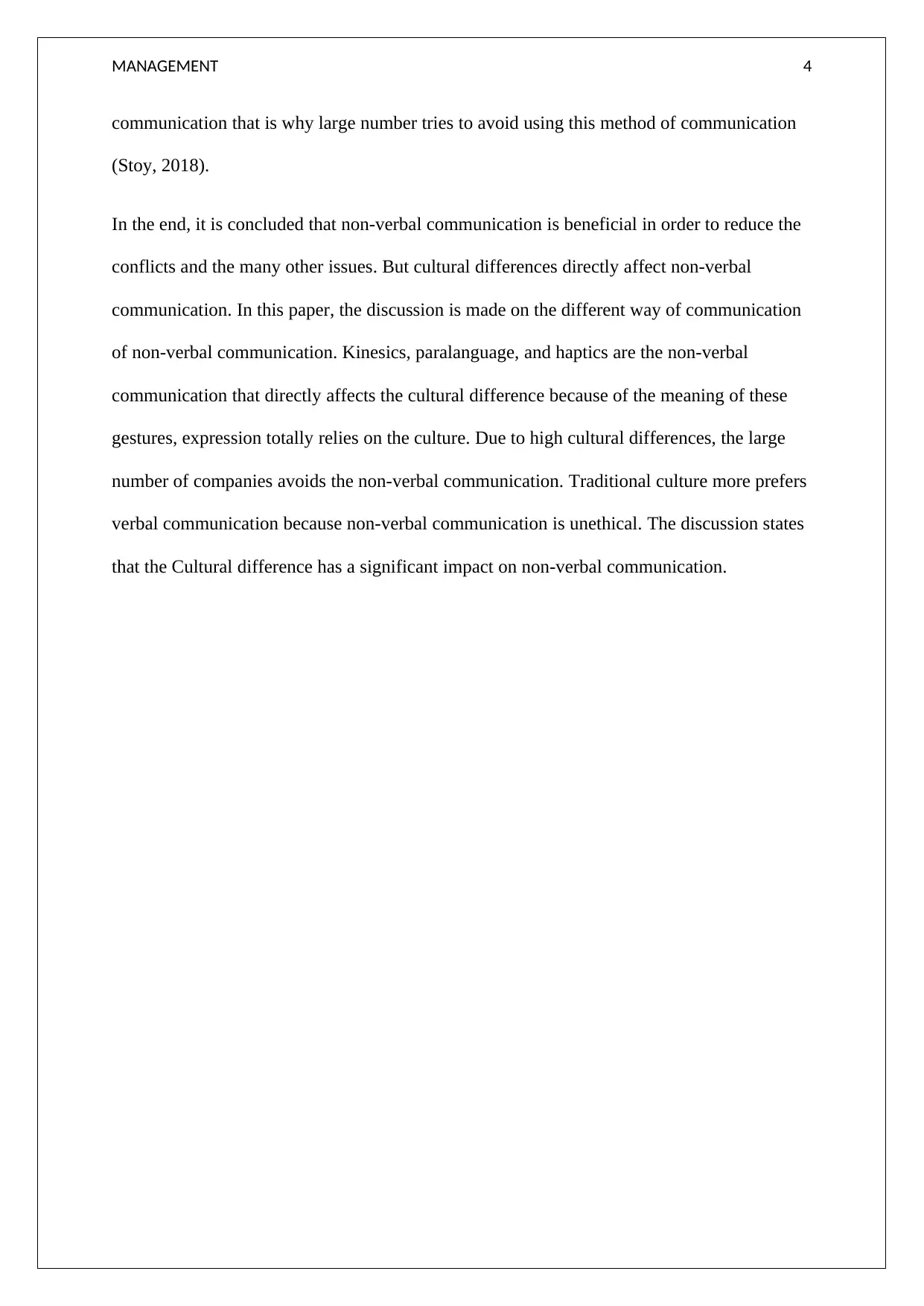
MANAGEMENT 4
communication that is why large number tries to avoid using this method of communication
(Stoy, 2018).
In the end, it is concluded that non-verbal communication is beneficial in order to reduce the
conflicts and the many other issues. But cultural differences directly affect non-verbal
communication. In this paper, the discussion is made on the different way of communication
of non-verbal communication. Kinesics, paralanguage, and haptics are the non-verbal
communication that directly affects the cultural difference because of the meaning of these
gestures, expression totally relies on the culture. Due to high cultural differences, the large
number of companies avoids the non-verbal communication. Traditional culture more prefers
verbal communication because non-verbal communication is unethical. The discussion states
that the Cultural difference has a significant impact on non-verbal communication.
communication that is why large number tries to avoid using this method of communication
(Stoy, 2018).
In the end, it is concluded that non-verbal communication is beneficial in order to reduce the
conflicts and the many other issues. But cultural differences directly affect non-verbal
communication. In this paper, the discussion is made on the different way of communication
of non-verbal communication. Kinesics, paralanguage, and haptics are the non-verbal
communication that directly affects the cultural difference because of the meaning of these
gestures, expression totally relies on the culture. Due to high cultural differences, the large
number of companies avoids the non-verbal communication. Traditional culture more prefers
verbal communication because non-verbal communication is unethical. The discussion states
that the Cultural difference has a significant impact on non-verbal communication.
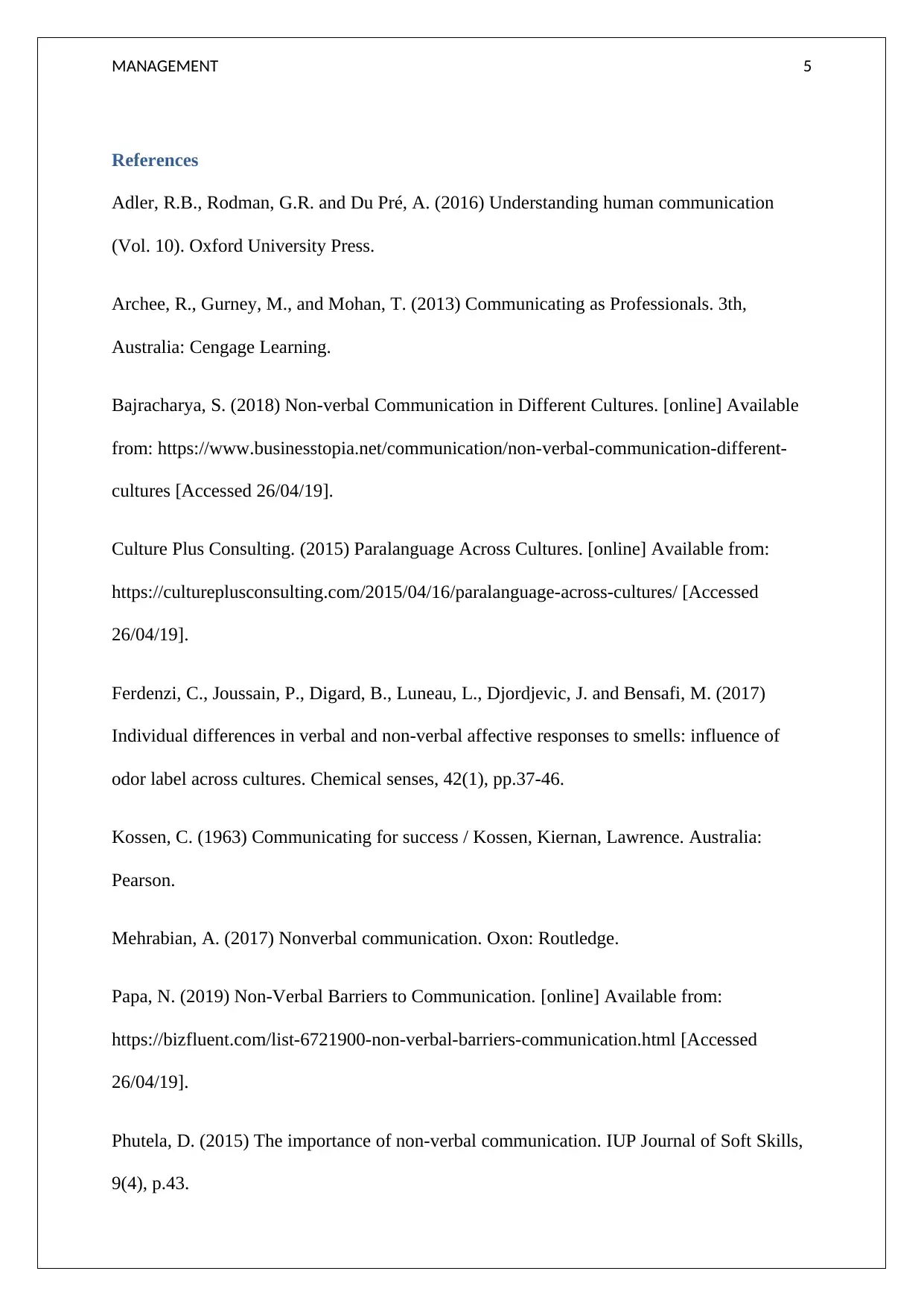
MANAGEMENT 5
References
Adler, R.B., Rodman, G.R. and Du Pré, A. (2016) Understanding human communication
(Vol. 10). Oxford University Press.
Archee, R., Gurney, M., and Mohan, T. (2013) Communicating as Professionals. 3th,
Australia: Cengage Learning.
Bajracharya, S. (2018) Non-verbal Communication in Different Cultures. [online] Available
from: https://www.businesstopia.net/communication/non-verbal-communication-different-
cultures [Accessed 26/04/19].
Culture Plus Consulting. (2015) Paralanguage Across Cultures. [online] Available from:
https://cultureplusconsulting.com/2015/04/16/paralanguage-across-cultures/ [Accessed
26/04/19].
Ferdenzi, C., Joussain, P., Digard, B., Luneau, L., Djordjevic, J. and Bensafi, M. (2017)
Individual differences in verbal and non-verbal affective responses to smells: influence of
odor label across cultures. Chemical senses, 42(1), pp.37-46.
Kossen, C. (1963) Communicating for success / Kossen, Kiernan, Lawrence. Australia:
Pearson.
Mehrabian, A. (2017) Nonverbal communication. Oxon: Routledge.
Papa, N. (2019) Non-Verbal Barriers to Communication. [online] Available from:
https://bizfluent.com/list-6721900-non-verbal-barriers-communication.html [Accessed
26/04/19].
Phutela, D. (2015) The importance of non-verbal communication. IUP Journal of Soft Skills,
9(4), p.43.
References
Adler, R.B., Rodman, G.R. and Du Pré, A. (2016) Understanding human communication
(Vol. 10). Oxford University Press.
Archee, R., Gurney, M., and Mohan, T. (2013) Communicating as Professionals. 3th,
Australia: Cengage Learning.
Bajracharya, S. (2018) Non-verbal Communication in Different Cultures. [online] Available
from: https://www.businesstopia.net/communication/non-verbal-communication-different-
cultures [Accessed 26/04/19].
Culture Plus Consulting. (2015) Paralanguage Across Cultures. [online] Available from:
https://cultureplusconsulting.com/2015/04/16/paralanguage-across-cultures/ [Accessed
26/04/19].
Ferdenzi, C., Joussain, P., Digard, B., Luneau, L., Djordjevic, J. and Bensafi, M. (2017)
Individual differences in verbal and non-verbal affective responses to smells: influence of
odor label across cultures. Chemical senses, 42(1), pp.37-46.
Kossen, C. (1963) Communicating for success / Kossen, Kiernan, Lawrence. Australia:
Pearson.
Mehrabian, A. (2017) Nonverbal communication. Oxon: Routledge.
Papa, N. (2019) Non-Verbal Barriers to Communication. [online] Available from:
https://bizfluent.com/list-6721900-non-verbal-barriers-communication.html [Accessed
26/04/19].
Phutela, D. (2015) The importance of non-verbal communication. IUP Journal of Soft Skills,
9(4), p.43.
⊘ This is a preview!⊘
Do you want full access?
Subscribe today to unlock all pages.

Trusted by 1+ million students worldwide

MANAGEMENT 6
Stoy, A. (2018) Nonverbal Communication: Different Cultures, Different Meanings for
Project Teams. [online] Available from:
https://www.brighthubpm.com/monitoring-projects/85141-project-communication-tips-
nonverbal-communication-in-different-cultures/ [Accessed 26/04/19].
Stoy, A. (2018) Nonverbal Communication: Different Cultures, Different Meanings for
Project Teams. [online] Available from:
https://www.brighthubpm.com/monitoring-projects/85141-project-communication-tips-
nonverbal-communication-in-different-cultures/ [Accessed 26/04/19].
1 out of 7
Related Documents
Your All-in-One AI-Powered Toolkit for Academic Success.
+13062052269
info@desklib.com
Available 24*7 on WhatsApp / Email
![[object Object]](/_next/static/media/star-bottom.7253800d.svg)
Unlock your academic potential
Copyright © 2020–2025 A2Z Services. All Rights Reserved. Developed and managed by ZUCOL.




